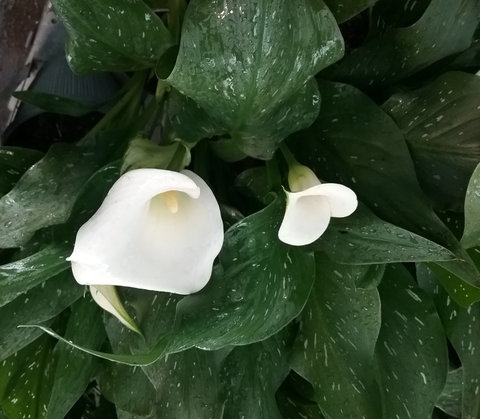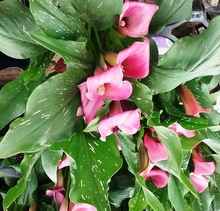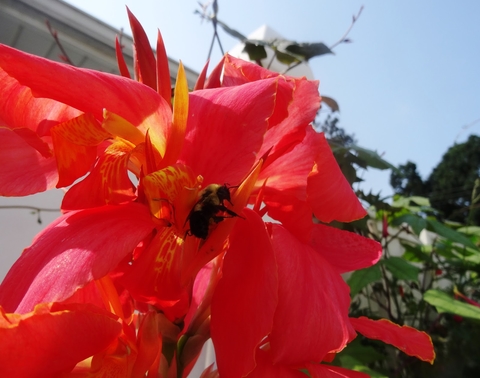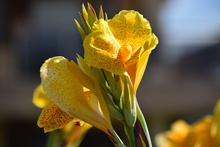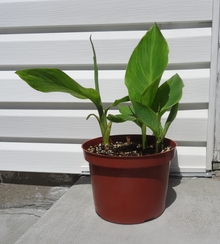Quick facts
- Cannas and calla lilies are available in many different flower colors and leaf types and make a dramatic, tropical statement in the garden and in containers.
- Canna and calla lilies are grown as summer annuals and as houseplants in colder climates.
- In Minnesota, canna and calla lily rhizomes must be dug up in the fall and kept indoors over winter.
Calla lilies
Calla lilies or callas (Zantedeschia species) are not true lilies. They are related to jack-in-the-pulpit and Caladium. Unlike jack-in-the-pulpit, they are not hardy in Minnesota.
The tuber-like rhizomes of callas must be dug up and stored inside over the winter. They can be potted in late winter and cared for like a houseplant until temperatures are warm enough for them to grow outside.
Callas have a broad, trumpet-shaped flower called a spathe that wraps around the finger-like spadix. The spathe is a modified leaf and may be white, yellow, peach, orange, red, pink, purple or bicolored.
The spadix holds the tiny, true flowers. Its leaves are arrowhead-shaped and solid green or green with silver or white flecks.
Zantedeschia aethiopica, the white calla, is native to Africa where it is considered a weed. The flowers can be quite large, with a spathe up to 10 inches long and a yellow spadix. It has also become naturalized in warm parts of the U.S., such as in California, where it is an invasive species. Because it is not hardy in Minnesota, invasiveness is not a concern here.
Growing calla lilies
- Callas thrive in deep, moist, rich soil in full sun.
- While they will grow in part shade, calla lilies will bloom more profusely in full sun.
- White callas will grow in boggy or alkaline soils.
- Plant rhizomes four to six inches deep and one to two feet apart.
- Fertilize in spring after planting them, using a 5-10-5 or 5-10-10 fertilizer.
- A soil test is recommended every three to five years for lawns and gardens.
Callas may be grown as houseplants in a sunny window or under grow lights. However, for the best performance, callas should be planted in the garden or in containers outside in the summer where they should bloom from July through August. You can also enjoy calla lilies as cut flowers indoors.
Canna lilies
Canna lilies or cannas (Canna x generalis) are native to tropical and subtropical areas. They are not hardy in Minnesota.
Like callas, their rhizomes must be dug up in the fall after frost has blackened the foliage.
- Cannas grow 1 1/2 to 5 feet or more, depending on variety.
- Their large, glossy leaves are 6 to 12 inches wide.
- The exotic leaves come in bronze, purple, burgundy, bright green, dark green or even multicolored, so cannas are ornamental even without their flowers.
- Their blossoms are clustered at the top of flower spikes that can be up to one foot long.
- Blossom size varies with the species planted.
- Cannas are available in red, rose/pink, yellow, orange, salmon and red with yellow.
- They make excellent plants for large containers, in raised beds and as background plants. The flowers of some varieties are attractive to pollinators including hummingbirds and bumble bees.
Planting
Cannas may be started indoors by planting them three to four inches deep in pots, and then transplanting them outside. They will also bloom well if planted directly into the garden as soon as the soil has warmed and the danger of frost has passed.
- Plant the rhizomes 3 to 4 inches deep and 1 1/2 to 3 feet apart.
- Cannas grow best in full sun and hot weather, providing they have adequate moisture and soil high in organic matter.
- They will bloom in a warm site that gets part-day sun, such as along a house wall.
- They bloom mid-summer to frost.
Overwintering
- In the fall, dig up the rhizomes, cut the stems back to 2 to 3 inches, and let them dry.
- Leave them in a box in a cool part of the house where they will not freeze, such as a basement where the temperatures range between 40 to 50 degrees.
- Every few years, the rhizomes may be divided. When dividing, each piece must have an eye, or growing point, on it.
- Let the cut-up rhizomes dry for a few days before planting them.
Reviewed in 2024


